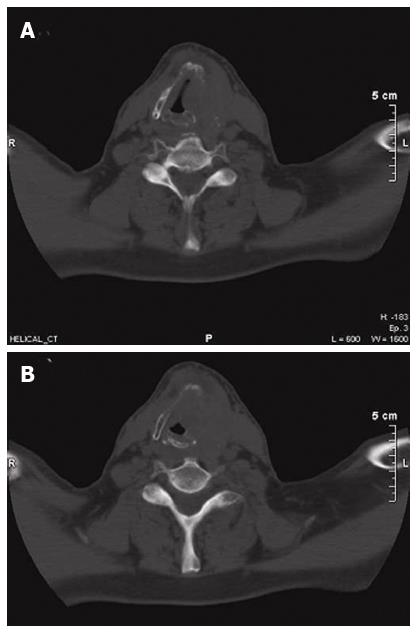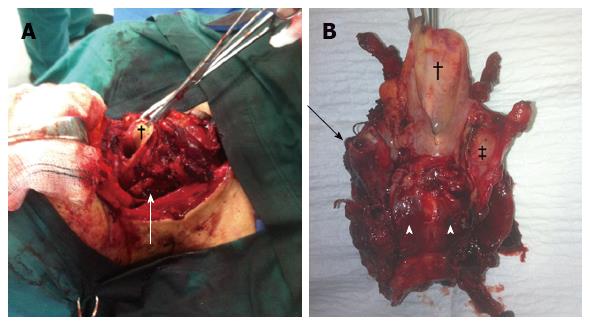Published online Jul 16, 2016. doi: 10.12998/wjcc.v4.i7.187
Peer-review started: February 29, 2016
First decision: April 15, 2016
Revised: April 28, 2016
Accepted: May 17, 2016
Article in press: May 27, 2016
Published online: July 16, 2016
Processing time: 129 Days and 14.5 Hours
Papillary carcinoma of the thyroid is the commonest type of thyroid cancer. Laryngeal infiltration from papillary thyroid carcinoma is extremely rare, with only a few cases of partial invasion described in the literature. We present a very unusual case of complete infiltration of both thyroid and cricoid cartilages from a neglected papillary thyroid carcinoma in a 59-year-old male. This sequel resulted from refusal of the patient to undergo treatment when initially diagnosed. An invasion to such an extent has not been described in the literature before, and in this case warranted a total laryngectomy followed by radioactive iodine. Prompt management of papillary carcinomas is crucial for avoiding such complications. Future guidelines should include management options for the patients who deny treatment initially.
Core tip: Aerodigestive tract invasion from a differentiated thyroid cancer is a very rare complication. This is the first case in the literature describing an infiltration to the thyroid and cricoid cartilages to such an extent, requiring a total laryngectomy followed by radioactive iodine treatment. Future guidelines should include management options for patients who refuse treatment during the initial stages of the disease.
- Citation: Georgiades F, Vasiliou G, Kyrodimos E, Thrasyvoulou G. Extensive laryngeal infiltration from a neglected papillary thyroid carcinoma: A case report. World J Clin Cases 2016; 4(7): 187-190
- URL: https://www.wjgnet.com/2307-8960/full/v4/i7/187.htm
- DOI: https://dx.doi.org/10.12998/wjcc.v4.i7.187
To date laryngeal infiltration and specifically infiltration of the cricoid cartilage from papillary thyroid carcinoma is extremely rare[1]. Here we present an unusual case with complete infiltration of both thyroid and cricoid cartilages from a neglected papillary thyroid carcinoma. A few cases have been described in the literature[2-4], but never before to such extent.
A 59-year-old man presented to our outpatient clinic with a midline neck mass, stridor, dyspnoea, hoarseness and dysphagia. These symptoms developed gradually within the past year, with dyspnoea being his main concern. Fine needle aspiration of a thyroid nodule a year before revealed papillary carcinoma; however, due to serious health issues concerning his son and subsequent development of depression, he refused treatment at that time.
His past medical history included diabetes mellitus, hypertension, hypercholesterolaemia, depression, stage 3 chronic kidney disease and two acute myocardial infarctions, in 1992 and in 2010. In 1994, he had undergone coronary artery bypass graft surgery. He had a 40 pack-years smoking history and was consuming about 35 alcohol units per week for several years.
On examination he was tachypnoeic, with a breathy biphasic stridor and low oxygen saturations. The palpable midline neck mass was a non-tender, immobile, hard mass with irregular borders, extending below the anterior borders of the sternocleidomastoid muscle, without displacement of the trachea. Cervical lymph nodes were palpable bilaterally at levels II-IV and at level VI, with none in the posterior triangle. Flexible laryngoscopy demonstrated right vocal cord fixation and diffuse laryngeal oedema.
A neck computed tomography scan revealed a 5.5 cm × 2.5 cm irregular soft tissue mass at the level of the thyroid cartilage. Bilateral thyroid and cricoid cartilage infiltration was evident, more on the left thyroid cartilage lamina than the right (Figure 1). The mass had infiltrated the lumen of the larynx, decreasing the diameter of the airway to approximately 0.5 cm, with associated lymph nodes detectable bilaterally.
The patient underwent emergency tracheostomy, to secure the airway. Biopsies taken from the neck mass itself, a lymph node at level VI on the left side and from the first tracheal cartilage, confirmed the mass to be thyroid papillary carcinoma with metastatic lymph nodes at level VI. The multidisciplinary team meeting decided to proceed with a total laryngectomy, a total thyroidectomy and a selective bilateral neck dissection of levels II-IV and VI. The oncologists suggested an ablative dose of radioactive iodine post-operatively.
A wide-field total laryngectomy approach was followed. The infiltration was readily visible intra-operatively (Figure 2A). A tracheo-oesophageal puncture was made with primary placement of a voice prosthesis. Histology, from the completely excised mass and larynx (Figure 2B), further established the well-differentiated papillary thyroid carcinoma that was infiltrating thyroid and cricoid cartilages of the larynx, the true and false vocal cords bilaterally with level II lymph nodes metastases on the left side and an area with dermal metastasis. The surgical limits and lymph nodes, at levels III and IV on the left side, levels II-IV on the right side and centrally, were clear of metastases.
At 13 mo post-op, the patient had completed his radioactive iodine treatment course, without any signs of relapse. He had weekly sessions with the speech and language therapists and was using his speech valve to communicate.
To date, laryngeal infiltration and specifically infiltration of the cricoid cartilage from papillary thyroid carcinoma are extremely rare[1,3]. The literature is very limited on laryngeal invasion from papillary thyroid carcinomas and their management with a few case reports[2] or retrospective cohort studies[3,4]. However, a laryngeal infiltration to such an extent has never been described in the literature until now.
The incidence of thyroid carcinomas invading the aerodigestive tract ranges from 1%-8%, with the majority of these being anaplastic thyroid carcinomas[1]. This broad category includes invasion of other structures other than the larynx, such as the trachea, hypopharynx and the oesophagus, which makes laryngeal invasion from thyroid cancers a very rare complication. For invasions of the aerodigestive tract from thyroid cancers a classification proposed by Dralle et al[5] exists; describing six types of laryngotracheal invasion and their proposed operative management. According to this classification, total laryngectomy is indicated with bilateral larynx invasion or vertical tracheal invasion of more than 5-6 cm[1]. Moreover, the vast majority of these cases are treated promptly before invasion to surrounding structures occurs.
According to the most recent tumour site, node metastases, distant metastases classification for differentiated thyroid cancer, invasion beyond the thyroid capsule is considered as T4[6]. The radiological and histopathology findings in the above described case placed the patient to a T4aN1bM0 classification and Stage IVA, which has a 10-year relative survival rate of 75.9%[6].
Current guidelines[6] focus mostly on the secondary and tertiary care management of patients with thyroid malignancies, with lack of management options for patients who refuse treatment, despite medical advice. In our case, the patient was fully informed about his condition and treatment options, but refused to be treated, when initially presented with a thyroid nodule. At the time of his initial presentation, his son had serious health problems, requiring 24 h support at home, especially from his father. Our patient was reluctant to pursue any sort of treatment, as that would have rendered him unable to take care of his family. This situation raises many medico-legal and ethical issues, as by respecting this particular patient’s autonomy, the patient ended up with a permanent tracheostomy, compromising both his quality of life and life expectancy[7]. Does the liability remain with the patient or with the medical team?
A multidisciplinary approach is needed for the management of such advanced cases, as recommended by current guidelines[6]. However, the lack of management options from the guidelines, created an uncertainty into the actual management of this patient; due to the difficult social circumstances, as described above. Therefore, we recommend an imperative role of primary care physicians (e.g., general practitioners), community nursing services and/or healthcare visitors assisting in the management of such patients in the community; with prompt referral to secondary care services, prior to development of haemodynamic abnormalities, as seen in this case. Moreover, this case has allowed us to observe the natural progression of a well-differentiated papillary carcinoma, from a nodule to a large mass invading the aerodigestive tract in just 12 mo.
The above case highlights the importance of early active management of thyroid carcinomas, as extensive laryngeal infiltration could be one of the possible outcomes. An infiltration to such an extent warrants a total laryngectomy followed by radioactive iodine treatment for any residual malignant cells. However, further follow-up is required to assess the efficacy of such management plan.
The authors would like to thank the patient for agreeing to share this information about his condition.
A patient presented with a midline neck mass, stridor, dyspnoea, hoarseness and dysphagia.
Upper airway obstruction from a large midline neck mass with associated lymphadenopathy.
Any type of thyroid malignancy, lymphoma, benign thyroid disease, sarcomas, infections.
Initial blood tests revealed a hypochromic, normocytic anaemia, elevated glucose and serum cholesterol levels.
Computed tomography scan of the neck revealed a large mass infiltrating both the thyroid and cricoid cartilages.
Histology revealed a papillary thyroid carcinoma invading the thyroid and cricoid cartilage.
Total laryngectomy followed by radioactive iodine treatment.
Patient had a thyroid nodule 1 year prior to his presentation to us, which was investigate by fine-needle aspiration (FNA) to reveal a papillary thyroid carcinoma. Patient was reluctant to undergo any treatment due to specific social circumstances and refused follow-up. A year later he presented with advanced disease and symptoms warranting treatment.
FNA refers to fine needle aspiration. Laryngectomy involves removing the whole of the larynx and part of the proximal trachea, leaving an opening of the trachea superior to the sternal notch.
Patients who refuse treatment in the initial stages of the disease should be followed up in the community and referred to secondary care in a timely manner.
The authors described a case of extensive laryngeal infiltration from a neglected papillary thyroid carcinoma, which was managed with total laryngectomy and thyroidectomy, and selective neck dissection. The manuscript is interesting and well-written.
Manuscript source: Invited manuscript
P- Reviewer: Ghosh M, Li XL, Vlastarakos PV, Wax MK S- Editor: Ji FF L- Editor: A E- Editor: Wu HL
| 1. | Brauckhoff M. Classification of aerodigestive tract invasion from thyroid cancer. Langenbecks Arch Surg. 2014;399:209-216. [RCA] [PubMed] [DOI] [Full Text] [Cited by in Crossref: 19] [Cited by in RCA: 24] [Article Influence: 2.0] [Reference Citation Analysis (0)] |
| 2. | Ozturk K, Akyildiz S, Makay O. Partial laryngectomy with cricoid reconstruction: thyroid carcinoma invading the larynx. Case Rep Otolaryngol. 2014;2014:671902. [RCA] [PubMed] [DOI] [Full Text] [Full Text (PDF)] [Cited by in Crossref: 1] [Cited by in RCA: 2] [Article Influence: 0.2] [Reference Citation Analysis (0)] |
| 3. | Ballantyne AJ. Resections of the upper aerodigestive tract for locally invasive thyroid cancer. Am J Surg. 1994;168:636-639. [RCA] [PubMed] [DOI] [Full Text] [Cited by in Crossref: 49] [Cited by in RCA: 43] [Article Influence: 1.4] [Reference Citation Analysis (0)] |
| 4. | Moritani S. Surgical Management of Cricotracheal Invasion by Papillary Thyroid Carcinoma. Ann Surg Oncol. 2015;22:4002-4007. [RCA] [PubMed] [DOI] [Full Text] [Cited by in Crossref: 15] [Cited by in RCA: 15] [Article Influence: 1.5] [Reference Citation Analysis (0)] |
| 5. | Dralle H, Brauckhoff M, Machens A, Gimm O. Surgical management of advanced thyroid cancer invading the aerodigestive tract. Textbook on endocrine surgery. Philadelphia: Elsevier Saunders 2005; 318-333. |
| 6. | Perros P, Boelaert K, Colley S, Evans C, Evans RM, Gerrard Ba G, Gilbert J, Harrison B, Johnson SJ, Giles TE. Guidelines for the management of thyroid cancer. Clin Endocrinol (Oxf). 2014;81 Suppl 1:1-122. [RCA] [PubMed] [DOI] [Full Text] [Cited by in Crossref: 758] [Cited by in RCA: 774] [Article Influence: 70.4] [Reference Citation Analysis (0)] |
| 7. | Verburg FA, Mäder U, Tanase K, Thies ED, Diessl S, Buck AK, Luster M, Reiners C. Life expectancy is reduced in differentiated thyroid cancer patients ≥ 45 years old with extensive local tumor invasion, lateral lymph node, or distant metastases at diagnosis and normal in all other DTC patients. J Clin Endocrinol Metab. 2013;98:172-180. [RCA] [PubMed] [DOI] [Full Text] [Cited by in Crossref: 133] [Cited by in RCA: 133] [Article Influence: 11.1] [Reference Citation Analysis (0)] |










